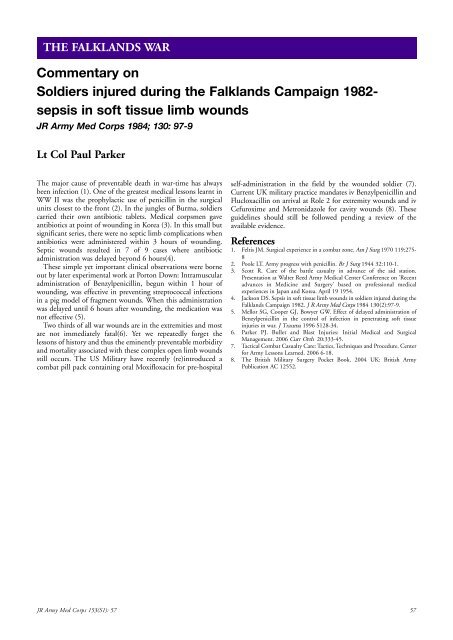Falklands war 25TH anniversarY - Boekje Pienter
Falklands war 25TH anniversarY - Boekje Pienter
Falklands war 25TH anniversarY - Boekje Pienter
You also want an ePaper? Increase the reach of your titles
YUMPU automatically turns print PDFs into web optimized ePapers that Google loves.
THE FALKLANDS WAR<br />
Commentary on<br />
Soldiers injured during the <strong>Falklands</strong> Campaign 1982-<br />
sepsis in soft tissue limb wounds<br />
JR Army Med Corps 1984; 130: 97-9<br />
Lt Col Paul Parker<br />
The major cause of preventable death in <strong>war</strong>-time has always<br />
been infection (1). One of the greatest medical lessons learnt in<br />
WW II was the prophylactic use of penicillin in the surgical<br />
units closest to the front (2). In the jungles of Burma, soldiers<br />
carried their own antibiotic tablets. Medical corpsmen gave<br />
antibiotics at point of wounding in Korea (3). In this small but<br />
significant series, there were no septic limb complications when<br />
antibiotics were administered within 3 hours of wounding.<br />
Septic wounds resulted in 7 of 9 cases where antibiotic<br />
administration was delayed beyond 6 hours(4).<br />
These simple yet important clinical observations were borne<br />
out by later experimental work at Porton Down: Intramuscular<br />
administration of Benzylpenicillin, begun within 1 hour of<br />
wounding, was effective in preventing streptococcal infections<br />
in a pig model of fragment wounds. When this administration<br />
was delayed until 6 hours after wounding, the medication was<br />
not effective (5).<br />
Two thirds of all <strong>war</strong> wounds are in the extremities and most<br />
are not immediately fatal(6). Yet we repeatedly forget the<br />
lessons of history and thus the eminently preventable morbidity<br />
and mortality associated with these complex open limb wounds<br />
still occurs. The US Military have recently (re)introduced a<br />
combat pill pack containing oral Moxifloxacin for pre-hospital<br />
self-administration in the field by the wounded soldier (7).<br />
Current UK military practice mandates iv Benzylpenicillin and<br />
Flucloxacillin on arrival at Role 2 for extremity wounds and iv<br />
Cefuroxime and Metronidazole for cavity wounds (8). These<br />
guidelines should still be followed pending a review of the<br />
available evidence.<br />
References<br />
1. Feltis JM. Surgical experience in a combat zone. Am J Surg 1970 119:275-<br />
8<br />
2. Poole LT. Army progress with penicillin. Br J Surg 1944 32:110-1.<br />
3. Scott R. Care of the battle casualty in advance of the aid station.<br />
Presentation at Walter Reed Army Medical Center Conference on 'Recent<br />
advances in Medicine and Surgery' based on professional medical<br />
experiences in Japan and Korea. April 19 1954.<br />
4. Jackson DS. Sepsis in soft tissue limb wounds in soldiers injured during the<br />
<strong>Falklands</strong> Campaign 1982. J R Army Med Corps 1984 130(2):97-9.<br />
5. Mellor SG, Cooper GJ, Bowyer GW. Effect of delayed administration of<br />
Benzylpenicillin in the control of infection in penetrating soft tissue<br />
injuries in <strong>war</strong>. J Trauma 1996 S128-34.<br />
6. Parker PJ. Bullet and Blast Injuries: Initial Medical and Surgical<br />
Management. 2006 Curr Orth 20:333-45.<br />
7. Tactical Combat Casualty Care: Tactics, Techniques and Procedure. Center<br />
for Army Lessons Learned. 2006 6-18.<br />
8. The British Military Surgery Pocket Book. 2004 UK: British Army<br />
Publication AC 12552.<br />
JR Army Med Corps 153(S1): 57 57

















